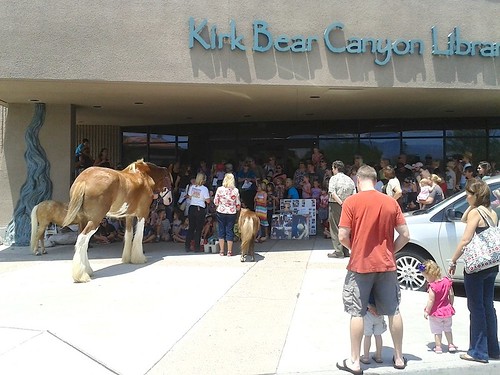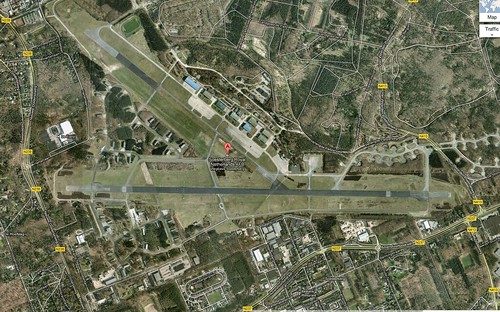I went to the library earlier today and found the entrance area crowded with parents and small children. I wondered, for a minute, if the library was holding a fire drill, but I was able to squeeze through the kids and get inside, where I checked out a book they were holding for me. By the time I was ready to leave the crowd had grown even larger, and now there were horses too. Once outside again, I took a photo:

At the time, the only horse that registered on my eyeballs was the giant percheron … I didn’t notice the two small ponies standing next to it until I uploaded the photo to Flickr and finally took a good look at it. I must have shown up in the middle of one of the library’s summer family programs, and the families were there to show their kids what horses look like. How nice.
Seeing that percheron triggered a memory, one I’ll share with you.
In 1980 or 1981, while I was stationed at Soesterberg Air Base in the Netherlands, NATO hit us with a tactical evaluation, their version of an operational readiness inspection. The exercise scenario was that the Warsaw Pact had stormed across the Fulda Gap into what was then West Germany, and we were at war. Our mission, air defense of the northern tier of Europe, required us to launch against invading enemy fighters and bombers and shoot them down. Everyone who wasn’t actually flying was hunkered down in hardened bunkers and aircraft shelters, wearing full chemical gear and gas masks, simulating that we were under chemical and biological attack.
Every F-15 had its own hardened shelter, dispersed in the woods surrounding the taxiways and runway. When not actually flying or taxiing to or from the runway, the jets were under cover. Maintenance, refueling, weapons loading: it all happened inside the bunkers. Those of us who were not flying were in bunkers too, sucking air through the filters of our gas masks.

I’d flown that morning, but now it was the afternoon and I was pulling Baron duty. Baron is what we called our mobile supervisor of flying. Normally, whenever our F-15s flew, we’d post an experienced pilot in the Dutch control tower, where he could talk to pilots on the radio and assist with any emergencies. But when we simulated war we assumed the tower would be unavailable to us, so we made the SOF mobile, putting him in a pickup truck with a portable UHF radio. As Baron, I was supposed to move about the taxiways, communicating with the command post and airborne pilots when needed, taking cover inside the nearest aircraft shelter during simulated airfield attacks.
Suddenly I got a radio call from the command post, the underground bunker from which the colonels were running our war scenario: “Baron, there’s a dead horse on the runway.” Say what? Everyone but me was locked inside a bunker, unable to look out a window to see what was actually going on outside, and now someone … probably a Dutch Air Force guy from the other side of the base, where they are not at “war” … had told the command post there was a dead horse on the runway. Ten of our F-15s were homeward bound from northern Germany, where they’ve been fighting other NATO jets simulating the bad guys. They were low on fuel, and if they couldn’t land at Soesterberg and had to go to an alternate instead it would have been a major disruption, and it was up to me to sort things out.
There was a length of rope and some tire chains in the bed of the truck, and as I drove through the woods toward the runway I was already trying to think how I could use them to drag a dead horse off the runway … and then I got to the runway and looked right, then left, and there was nothing on the runway but tire marks and paint. No horse, dead or alive.
I radioed back to the command post, reporting that the runway was clear. They told me no, there was a dead horse on the runway. I could tell from the way they were breathing, as well as the tinny sound of their voices, that they had their gas masks on, as did I. Which made the conversation all the harder to understand. They suggested diverting the recovering aircraft to Gilze-Rijen Air Base. I explained once again that there was no dead horse and that the runway was fine. After some back and forth, it began to dawn on one of the underground colonels that perhaps I, as the only party to the argument who could actually see the runway, might have a point. Even so I had to get the Dutch tower controller on the radio and bring him into the conversation. No, he couldn’t see a dead horse either. By then our jets were ten miles out. Crisis averted.
Later on I called the Dutch tower controller on a landline. He told me that earlier in the day they’d been clearing some dead trees from the woods near the west end of the runway, dragging stumps out of the ground with a couple of big draft horses.
Did you ever play that telephone game in school? That’s what happened that day. Someone on the Dutch side of the base said something about horses pulling stumps, and after a few repetitions it morphed into a dead horse on the runway. With everyone on our side of the base hunkered down in windowless shelters, sucking air through gas masks while dealing with hundreds of other radio, telephone, and telex reports, the only safe course of action was to believe it. Until, that is, the one person allowed to be outdoors could be sent to check it out … and even then, the colonels clung to their dead horse theory!
in 1988, on the day the USS Vincennes shot down Iran Air Flight 655, I was a joint staff officer at US Special Operations Command, next door to US Central Command Headquarters at MacDill AFB in Florida. The Vincennes was under CENTCOM control when it launched that missile, and everyone who worked there had been recalled in the middle of the night, right after the shootdown. We at USSOCOM were not involved, but the CENTCOM guys and girls were our neighbors and friends, and we knew what was up.
As a matter of fact, we knew more about what was up than they did. By the time we got into work, around 0700 that morning, CNN was already showing footage of floating bodies, airline seats, and luggage. Next door at CENTCOM they were hunkered down in the dark, in the middle of what they regarded as a hot war. Even as CNN was telling the world we’d shot down an airliner by mistake, CENTCOM staff officers still believed … and were still reporting to their own four-star commander, who in turn was reporting uphill to the Pentagon and the White House … that the Vincennes had engaged and shot down an Iranian Air Force F-14 in self defense. It was the middle of the day before anyone next door was ready to admit they’d shot down an Airbus full of innocent passengers instead.
That day I remembered the dead horse … the horse that wasn’t dead, or even there. Every time I hear someone talk about the fog of war I think of that dead horse. Every time I hear the word SNAFU I think of that dead horse.
If there had been a dead horse on the runway, it probably would have looked like the percheron I encountered at the library today. I’m sure glad I didn’t have to figure out how to drag a giant dead horse like that off a runway, all by myself … even though that would have made for a better story.
If I ever own a percheron, I’m naming it SNAFU!